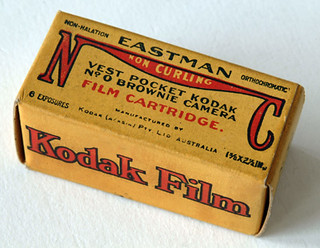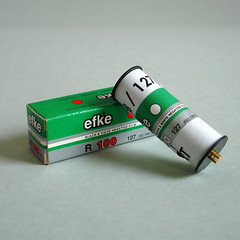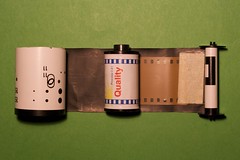127 film

|
| 127 film marked "Vest Pocket Kodak" 1930 expiry date image by Geoff Harrisson (Image rights) |
For cameras using 127, see the Category: 127 film.
History
127 film is a paper-backed rollfilm format designed for still photography. 127 film is 4.6cm wide and was originally designed to take eight pictures in 4x6.5cm format. It was created by Kodak in 1912 for their Vest Pocket model - hence 127 was sometimes called Vest Pocket film. Many of the first generation of 127 film cameras were similar folders, and frequently inherited Vest Pocket or VP in their names - for example the Dolly Vest Pocket. See Category: 4x6.5. Some early Kodak cameras made in 1913 and later included Kodak's patented Autographic feature, providing the photographer a way to write notations on the back of the film while shooting. Autographic film and cameras were labelled A127.
Because enlargements were uncommon during the early usage of 127 film, it was generally contact printed, resulting in 4 x 6.5 cm prints.
In 1930, during the Great Depression, the camera makers tried to economize on the use of film, and cameras began to appear taking 16 exposures in 3x4cm format on the 127 film, the first one being the Zeiss Ikon Kolibri. See Category: 3x4. These cameras often used dual red windows, where a particular frame number on the film backing paper was advanced to appear first in one, then the other window.

|
| image by Dries van den Elzen (Image rights) |
In Japan, the 127 film continued to be called "Vest film" (ベストフィルム; Besuto firumu) until approximately the 1950s.
In the 1950s there was a short revival of the 127 film with cameras designed to take 12 exposures in 4x4cm format. Several firms produced high-quality cameras, primarily twin-lens reflexes, in this format. The film was available in color slide emulsions, and the resulting 4x4cm slides could be projected in a normal projector designed for 24x36mm slides. They were advertised as Superslide. Kodak made such a range of very basic cameras. Rollei made a more advanced Rolleiflex Baby camera until the beginning of the 1960s. Tōgōdō and Yashica in Japan produced outstanding examples. See Category: 4x4.
After the 1960s, 127 film declined in popularity as camera manufacturers focused on 35mm. The 127 format, along with 120 and 620, became an official ISO medium-format film standard in 1975 with the publication of ISO 732. The 1982 revision of ISO 732 also included 127[1] but it was dropped from the third edition, published in 1991.[2] Kodak ended production of 127 in 1995 and other major manufacturers immediately followed, but film was still made by some smaller firms. Notably, Fotokemika ('Efke') of Croatia continued making its R100 ISO 100 black-and-white film in 127 size (among other sizes) until 2012. R100 was originally an Adox emulsion, which Fotokemika licensed in 1970;[3] interestingly, Efke supplied the film in many sizes to the new Adox company in Germany for sale under its own brand. Efke also made an infra-red film (IR820) in 127 size, though this was never widely available. In 2012 an equipment failure forced Fotokemika to close, and although Adox has replaced the R100 emulsion with a new one for 135, 120 and sheet film, the firm has not made this in 127 size.

|
| 120 film compared to 127 image by Dries van den Elzen (Image rights) |
Several films have been marketed under the Rollei brand; these films were made by (or for) the trading company Hans O. Mahn[4]; the company has no relation to Rollei/Franke & Heidecke, makers of Rolleiflex cameras, but has licensed the name. Maco's black-and-white film, Retro 80S (still available in 120 size) is an Agfa aerial-photography film. Other 127 film types were introduced for novelty uses: an E6 colour reversal film was sold as 'Crossbird', the available information encouraging C41 'cross-processing', though 'Superslide' mounts were sold alongside it. 'Nightbird' is ISO 500-800 C41 negative film, but spooled 'back to front', giving unusual colour effects. Mahn also sold a normal colour negative 127 film, Macocolor UCN200. As of November 2014, only Nightbird was still offered in 127 size by the Mahn web-shop (also Rerapan; see below).
Current Availability
Ezox of Hokkaido, Japan, primarily an agricultural machine company,[5] began distributing a black and white film in the spring of 2014 called Rerapan 100. In spring of 2016, they started distributing ReraChrome 100 colour reversal film. Both were still available as of 2023.
In 2006, Bluefire in Canada began manufacturing 127 C-41 color print films which were made using film stock from major factories, which was machine-rolled onto custom-manufactured spools and backing paper. Bluefire Police was black-and-white film made for use as microfilm, cut and spooled for 127 format.
Dick Haviland, a retired Kodak executive trading as Film for Classics[6], has for many years made 127 films (and other near-obsolete sizes) by hand from salvaged spools and custom-printed backing paper, which he sells through major on-line retailers including B&H Photo of New York.
Ilford Photo (Harman Technology) has since about 2012 made 50-foot x 46 mm-wide rolls of HP5 available in their 'Ultra Large Format' program, whereby film in unusual sizes is ordered via distributors (and paid for) in around June, and delivered in the autumn. Some distributors (including B&H) appear to have arranged to have this bulk film spooled.
127 Film Holidays
There are currently 3 different Camera Holidays that celebrate the use of 127 film. The idea of a world-wide holiday when photographer shoot 127 film in vintage cameras originated at the UK website OneTwoSeven.org.uk in November of 2004.[7] Several dates were discussed. One became the commonly celebrated world-wide 127 film holiday and two others were later adopted as local US 127 film holidays. On all three of these dates, large numbers of photographers load and shoot 127 film, posting the resulting photos online, usually to the Flickr 127 film group.[8][9]
- World 127 Day - Celebrated on 12 July - This is first and largest 127 holiday. It is celebrated by 127 camera users worldwide. The holiday was established by the users of the UK website OneTwoSeven.org.uk in 2004. The date was selected because of the similarity of the standard ISO rendering of the date to the film format (i.e. the date for July 7 is rendered as "12/7" is similar to 127)
- American 127 Day - Celebrated on 7 December - This date has been celebrated as the US-specific 127 camera holiday since 2006. It was first suggested in 2004 when the date for World 127 day was being selected but was rejected because it relies on a non-standard way of rendering the date. Some years later it was picked up by American 127 film enthusiasts. the date is based on the similarity of the US-style rendering of the date to the film format (i.e. the date December 7 is rendered as "12/7", similar to 127).
- Winter 127 Day - Celebrated on 27 January - The most recently adopted 127 day was added in 2009. It follow closely after American 127 day, offering those who missed the primary American 127 holiday a second chance. Like 7 December, this date was suggested and rejected in 2004 as a potential date for World 127 Day. The Date is based on the similarity of the US-style rendering of the date to the film format (i.e. the date January 27 is rendered as "1/27", similar to 127).
See Also
- 127 Film Cameras - a list of 127 film camera document here at Camera-Wiki
- Category: 4x6.5 - a list of cameras using the 4 x 6.5 format
- Category: 4x4 - a list of cameras using the 4 x 4 format
- Category: 3x4 - a list of cameras using the 3 x 4 format
Notes
- ↑ ISO 732, 1982 edition
- ↑ ISO 732, 1991 edition
- ↑ Fotokemika History
- ↑ The Rollei Photo-Technik page (archived) for Rollei Film comprises only links to Mahn's websites.
- ↑ Ezox products at Ezox
- ↑ Film for Classics
- ↑ 127 Photography forum: 127 Photography (archived)
- ↑ Camera Calendar
- ↑ Flickr Group: 127 film
Links

|
| A method for using 35mm film in a camera designed for 127 image by Dirk HR Spennemann (Image rights) |
- Onetwoseven (more or less inactive site)
- 44 Club (archived); Japanese, but part of the website is in (system-translated) English
- How to load your 127 camera (pdf) (archived)
- 127 Format group on Flickr
- 127 (and 120) B/W films (archived) still listed by Fotokemika-Nova till 2021